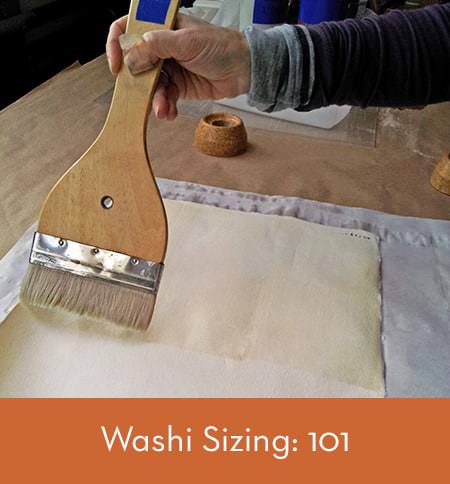 Many of our readers are quite knowledgeable when it comes to sizing your own paper, especially sizing your “go-to” paper.
Many of our readers are quite knowledgeable when it comes to sizing your own paper, especially sizing your “go-to” paper.
Here is a step-by-step “recipe” for cooking up your own sizing and applying it to your favorite Eastern paper.
The photos shown here are mostly depicting sizing made from wheat starch. Nope!, it’s not a gluten-free, but not a problem for the paper, and a nice alternative to animal-based sizing.
Exciting news regarding plant-based sizing… last night we received a new Eastern paper, already pre-sized with devil’s root starch, “konnyaku” -no animals used at all with this process, only human labor. Photos will be posted soon on social media.
We have entertained many varying viewpoints on sizing and sizing recipes. What are yours? Please share below, along with your experiences in making your own sizing. In the meantime, enjoy our sizing tests, made in our paper “kitchen”, here in Providence.
Adding sizing to paper affects the paper fibers’ sensitivity to humidity, absorption, and bleeding. There are many materials that can be used to size paper; we will cover the sizing procedure for gelatin size and wheat paste. It is not unlike cooking, where 90% of the procedure is preparation. This method allows for easy application with a large soft-bristle brush.
Gelatin Sizing Recipe:
This is the recipe for rabbit skin glue that can be used to size paper. (Please note: the gelatin size will need to be prepared 8-12 hours in advance.) What you will need:
- Rabbit skin glue: 1/3 Cup (powdered or solid sticks)
- Crystalline Alum: 1 Pinch (potassium aluminum sulfate)
- Double boiler with lid (a glass jar and sauce pan will also work)
- 16–32 oz. plastic / glass container (glass is recommended)
- Soft-bristle brush
Step One: Soak the glue in a quart of cold water for several hours until it swells and softens. (With solid sticks this may take overnight or 12+ hours).
Step Two: Once the glue has softened and becomes gelatinous, heat in a double boiler. The mixture should be stirred continuously until the gelatin has dissolved and the glue has become one consistent solution. (Note: never allow glue to boil). Remove from heat and stir in 1 pinch of alum. Allow the glue to cool slightly and apply warm to your paper. Apply one coat to the side you intend to use and allow to dry completely on newsprint. Additional coats may be added as necessary.
The remaining size solution can be saved in a jar in the refrigerator, and only requires heating to be used again. Note that storage length will vary from weeks to even months depending on several factors. Water quality is most important – bacteria and particulates can promote mold, and temperature should not be extreme. Solution should not freeze nor temps be too high.
Wheat Paste Recipe:
This is the recipe for wheat paste that can be used to size paper.(Please note: the wheat paste will need to be prepared one day in advance.) What you will need:
- Wheat starch: 1/3 cup
- Double boiler with lid (a glass jar and sauce pan will also work)
- 16–32 oz. plastic / glass container (glass is recommended)
- Measuring cup (1/4 cup – 1/2 cup size)
- Soft-bristle brush
- Nylon fabric
Step One: Fill the bottom of the double boiler with cold water and place on your heat source at a medium heat setting and bring to a low boil. (Alternatively, if you do not have a double boiler a glass jar placed in a saucepan works as well. Add enough water to submerge 1/3 of the jars height.) 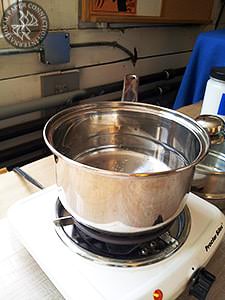
Step Two: While you are waiting, measure out your wheat starch and water. We used a 4:1 ratio. 4 parts water to 1 part wheat starch: 11/3 cup of water to 1/3 cup of wheat starch. Mix the starch and water together in the top pan of the double boiler, (or the jar for those who are not using the double boiler) Mix thoroughly, making sure none of the starch has stuck to the bottom. The resulting mixture should be an opaque white solution resembling milk.
Once you have mixed the ingredients place the pan over the boiling water (or place your jar in the pan) and stir continuously until the mixture begins to thicken. The mixture will thicken to the consistency of heavy cream and small “chunks” will begin to form. Continue stirring until smooth and the mixture has the consistency of custard.
Step Three: Now the mixture can be covered and allowed to cook over a low boil for 25 minutes, with a quick stir every 5 minutes. The paste should continue to thicken and become somewhat translucent as it cooks. After you’ve allowed the paste to cook, add small amounts of hot water from the pan to your mixture and stir until the paste is smooth and custard like.
Pour the paste from your pan into your designated container and allow it to cool in a refrigerator over night. This is to allow the paste to gel into a homogeneous solid.
Step Four: Once the paste has gelled, wring a small amount through a piece of fabric: nylon, cotton, handkerchief, etc… Slowly add small amounts of water and mix with a brush until the paste is thin enough to apply with a brush to your paper. Apply one coat to each side and allow to dry completely on newsprint. Additional coats may be added as necessary.
Remember: As with all size, test for each use, and dilute as appropriate. If in doubt, thin and apply multiple coats. Allow the paper to completely dry between each coat. The best way to learn how much size to use, and when to use it is through experience and experimentation.


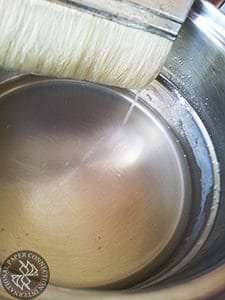
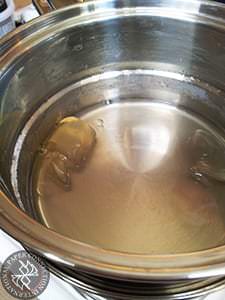
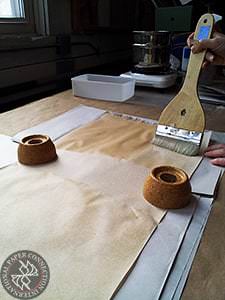
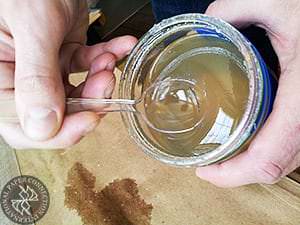
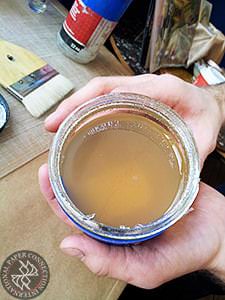
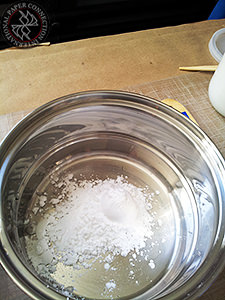
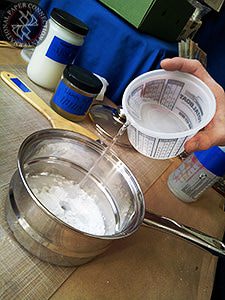


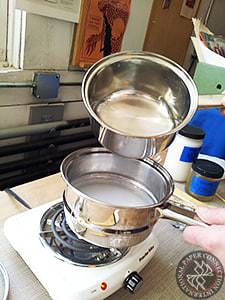
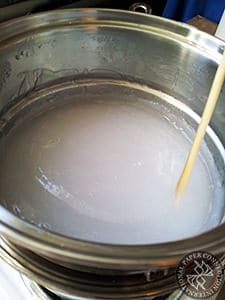
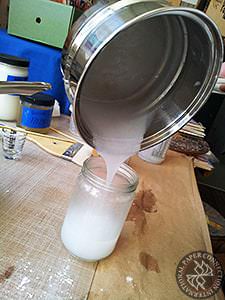
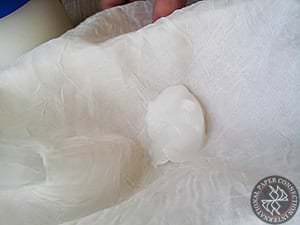


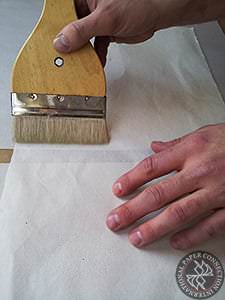
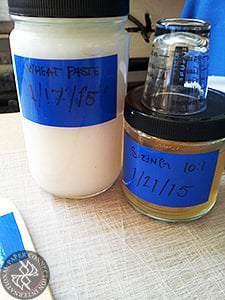
63 comments
Riva Brown
I am working on a series of paintings using Sumi-e ink on Bristol papers. The technique is to heavily wet the paper and float the ink onto the water. It seems that the sizing is interacting with the ink in an interesting way and I’d like to exploit that farther. What might a commercial western Bristol paper be sized with? Might you have an idea? I think I’d like to be able to float the sizing into the ink as it flows around the paper. Thoughts?
Paper Woman
Hi Riva, Although we don’t carry Western papers like Bristol, the surface sizing is probably something fairly strong, similar to rabbit’s skin glue. Using sumi ink on a Western paper is also unfamiliar to us. Why not buy marble sizing or “surfactant” to float in liquid which is used for techniques like “sumi-nagashi”. Hope that helps to guide you in the right direction.
Send us images of your work! we would love to see! contactus@paperconnection.com
Ash
I’ve seen some paper makers use the mucilage from boiling okra as sizing. Have you any experience with using that for sizing?
Paper Woman
Hi Ash, We’ve used the mucilage from okra for formation aid when making paper by hand. However, we do not have experience using it as a sizing.
Sheila marie vallejjo
Hi! What is the advantage of gelatin sizing over wheat sizing and vice versa?
Will the wheat starh make the paper stiff?
Paper Woman
Hi Sheila! Gelatin size often refers to that made from animal skin; at least it used to. The traditionalists wouldn’t necessarily use wheat starch to make size, but it definitely stiffens the paper….just like starching clothing.
Jenn
Thanks for all the great info! Does sizing (especially internal sizing) in paper degrade over time? I have some Rives paper that has been stored for quite a few years, and it seems to act different when wet, compared to a batch of the same Rives paper I just bought (which is presumably newer with “fresher” sizing.)
Paper Woman
Thank you for your question! Animal skin based sizing can degrade the paper over time. Sometimes the paper color gets darker more likely with surface sizing. Internal sizing probably less so. Depending how paper is stored and what it is made out of, you may not see any change for decades. In the case of “old” batch and newer batch of Rives, the sizing formula or the fiber content may have slightly changed from batch to batch. We don’t stock Rives, but we are curious how it’s acting different from batch to batch. Please let us know what happens with the Rives.
P.J.
I am looking to employ a Japanese technique called “Invisible writing” in which a sizing solution is used to create the image, then ink on the unsized side of the page will reveal the image. I have read that gum arabic can be used to replace animal glue in the sizing solution, but cannot find the proper ratio of water to gum arabic to alum. Any help would be greatly appreciated.
Paper Woman
P.J., I believe what you are looking for is information on Aburidashi. Perhaps that will help in your research. I did not come across any firm ratios to pass on. Good luck!
Aimee Danger
I’m looking for sizing for watercolor paper for doing gum bichromate printing. Gum bichromate is 4-color printing process that requires an hour soak inbetween each color. The problem I have is that the paper will often shrink between colors, but soaking and presoaking removes the original sizing. I’m wondering if either of these recipes require a reapplication after each soak.
Presoak, sizing, dry, solution, dry, print, soak, dry, sizing, dry, solution, dry, print, etc. VS.
presoak, sizing, dry, solution, dry, print, soak, dry, solution, dry, print, etc.
thepaperwoman
Aimee, The sizing depicted in this recipe may not be strong enough for the bum bichromate technique. However, wheat paste is relatively inexpensive, therefore you could try it without too much risk on the paste. We do stock other papers which may work well for your technique. Write us at paperexperts@paperconnection.com or check our webshop: shop.paperconnection.com
Melissa Aldosari
Can unflavored gelatin packets be used in place of rabbit skin glue? If so, would the quantities remain the same?
Thank you.
thepaperwoman
Finally, getting back to you Melissa. We wouldn’t think that would be a great replacement, but then again we never tried it. We imagine it would be too difficult to get the right consistency with gelatin and we have not heard of anyone trying the unflavored gelatin.
Our recipe uses 100% plain wheat powder for making wheat paste; one of the easiest rabbit skin glue alternatives available.
Jennifer
Can I use store bought wheat paste for sizing if I don’t want to make it myself?
Paper Woman
Yes you can, and there are many archival options available. We sell a powder starch glue at Paper Connection International which includes instructions: https://shop.paperconnection.com/products/diy-make-your-own-glue-craft-and-shoji-powder-starch
Danielle
Hi! I’m a manufacturing engineering student and our thesis involves producing a paper from the combination of wild sugarcane, water hyacinth, and recycled pulp. My group is aiming to produce a heavy weight paper that can be used for illustrations and paints. I was wondering what is the most suitable sizing agent for papers made from plant fibers. Thanks!
Paper Woman
Hi Danielle,
We suggest that you refer to Timothy Barrett’s comprehensive book on the history of paper making: http://paper.lib.uiowa.edu/european.php#sizing
Good luck with your thesis and do let us know how it all works out and we’d love to see images of the paper!
Marketa Holtebrinck
Hi, how long does paper treated with size have to ‘settle’ before printing? Is it the same for both the wheat paste and the gelatin? Thanks so much for your help!
Paper Woman
Hello Marketa,
Not sure what your question “settle” refers to. If you are interested in drying time, it will depend on how much sizing you apply and what type of paper you are sizing. You must wait until fully dry before printing in most cases – hope that helps!
Marketa Holtebrinck
Thanks for the reply. I’m talking about Japanese unsized papers that should ‘settle’ for some time after the sizing is complete – up to several months I’ve read somewhere. I’m printing water colour and wonder how the freshness of the size affects, or not, the process. Thanks!
Adamphotoman
I am contemplating a spray on application of the wheat based sizing. This would be after stretching, where the soaking will have removed some of the original sizing. This will slightly dampen the paper without too much of a soaking. Also the spray overlaps could be more even than using a brush.
Paper Woman
Great! Let us all know how your techniques work out and thank you for sharing.
Adamphotoman
Interesting that Marketa is talking about printing. Or is she talking about calligraphy?
I have been in the art reproduction business for a long time. I have seen the evolution in aqueous inkjet receptor coatings. The 1st canvas coatings were of a swell-able gelatine nature. Although this gelatine based coating was robust in many ways – [it was very stretchable and good for colour] – it was also very fragile. Even with a slight bit of water the coating and ink would frill and literally drip off the printed work. This necessitated overcoating with a toxic solvent based UV coating. The industry has now moved to an instant dry clay based coating, but this also has its failings. Clay is not very stretchable and does not adhere well to gesso.
Back to paper.
I am curious about the difference between these 2 types of sizings -[gelatine & gluten]. In particular about the difference between the fragility from rewetting an image or say a watercolour painting. I want to combine both pigmented aqueous inkjet and watercolour together. This would apply to pen and ink as well as to inkjet printing and to watercolour.
So is there a waterproof sizing?
Marcel Garbi
Thanks a lot for this lesson. I am really thirsty for learning about Japanese papers and mounting ways and it is very difficult to find serious info in English.
Two little questions:
1) How long does the wheat starch last kept in fridge?
2) Why do you recommend to do it both sides if we use only one?
I’m using kitakata.
I am working with ink and watercolours on wet, so having problems with fibers.
Thanks 🙂
Paper Woman
There are several factors that will impact how long the starch will last in the fridge – most importantly the quality of the water and secondly the temperature. Any bacteria, or other particulates in the water can create mold more quickly. You also do not want to freeze the paste, but it should be cool enough to inhibit bacteria.
As for coating, you need only coat the side you will work on, or choose to coat both and have the flexibility to work on either. We will update the post to reflect that info, thanks for noticing that!
Jen
Thanks for these clear instructions. What are the differences between wheat starch sized paper and gelatin sized paper?
Which method do you use most?
Paper Woman
Thanks for the great question Jen! There are many layers to this answer so we will do our best to clarify some key points. First and foremost it depends on several factors from what paper you are using to what process you are using. For example, for heavier weight papers that one might use for watercolor or heavy wet media, gelatin sizing would be a better choice. For chine colle or collage with thinner papers like gampi, one might consider using wheat starch as a better option. In the world of conservation, gelatin sizing is sometimes considered a better choice for stability, but it is really a multi-dimensional discussion. There are good reasons to use either dependent on your work.
If you direct message us via email, we can help you to find the best paper and sizing option for a particular project.
Jacob Lane
Hi I have a question! I sized an 8×4 feet sheet of paper and stretched it with a hair dryer. It was perfect and nicely flat. I did my drawing and laid it out in the sun as I needed it to dry quickly. However the sun’s heat has caused it to wrinkle.
How would I flatten it out again?
Many thanks!
Jacob
Paper Woman
Hello Jacob,
It would depend on what type of medium you used for your drawing. If it is possible to dampen the back of the paper slightly (without damaging your image), you may overlay another sheet of clean paper to the front and back sides of your work and apply gentle heat. Once it is slightly damp and you applied heat, you could use a firm sheet atop and weight it to flatten. It really does depend on what you’ve used to create your drawing. If you used wet media in your process which subsequently buckled your paper, it is sometimes impossible to completely flatten the surface.
Tim
I am having a hard time finding recipes for internal sizing for handmade cotton paper. Can you help?
Paper Woman
Hello Tim,
The amount of sizing, and which of our recipes to incorporate, will depend on what qualities you need the paper to embody. Sizing internally will involve experimenting during the molding stage and dependent on your artistic process for which the paper will be used.
From our blogpost on sizing this was our response from a previous customer question:
If you are hand-making paper from scratch, you can add sizing to to the vat (“internal sizing” or “vat sizing”). The amount of sizing would depend on what kind of art work you do and requires your own experimentation.
Let us know how else we can help with your work and if you have questions about our papers!
Also, you can go on to Hand Papermaking magazine’s online resource here which may provide a wealth of articles:
http://www.handpapermaking.ws/search.php
B_Evans
Would it be possible to infuse the paper with either sizing type during the molding stage of paper making(mixing an amount of sizing into the water the paper material is floating in before/while it’s being molded)?
Paper Woman
Dear B-Evans,
Yes. If you are hand-making paper from scratch, you can add sizing to to the vat (“internal sizing” or “vat sizing”). The amount of sizing would depend on what kind of art work you do and requires your own experimentation.
Manny
How do these sizing formulations dry? Glossy or not? I would like the paper to look the same as before the sizing, if possible.
Paper Woman
Hi Manny, The sizing may possibly have some gloss, but it does depend on your application of the recipe. Which paper are you applying it to? Using sizing darkens the surface of the paper, we have noticed. You may want to use paper that was internally-sized or “vat”-sized in the future. Like our Kozo Paper White 80gsm; it is internally sized, so it doesn’t look any different than unsized kozo paper. It all depends on the papermaker too.
Maria
Finally I got the correct recipes. Thanks a lot. I would like to know if allum is toxic.
Sarah
Alum is used in pickling and is not toxic.
Paper Woman
Hi Maria, I don’t think allum is toxic in small quantities. I think it’s even sold as a spice in supermarkets!
Paper Woman
It’s not really toxic. It is sold in the spice section at the supermarket.
Kay Allen
If I put the wheat starch on cardstock, will it become like watercolor paper and work the same way?
Paper Woman
Sure. However, cardstock typically already has a surface sizing. In other words, you should try painting on the cardstock first with watercolor paints to see what happens.
peter
Hi I would like to use craft paper or 90 lb drawing paper with ink and wash. Will this sizing prevent puckering when water us applied to the dry paper ?
Paper Woman
This sizing recipe is also wet, so it will may pucker Kraft paper as well.
yehuda sherez
Hello. Thanks for the recipes. What role alum, in the recipe of g’latin, and is it possible to use g’latin from another source?
Paper Woman
thank you for your question. We believe the alum helps the animal skin glue adhere better to the surface of the paper. It also can be used as a color retention agent.
However, it is not necessary to use with the wheat starch size recipe. Hopefully that helps. Thank you for your patience!
Don
Can wheat sizing be used on acid-free cellulose based watercolor paper to reduce pigment absorption and increace wet working time? Thank you.
Paper Woman
Sure. additional size added to the surface of watercolor paper, should create more of a barrier between the pigment and the paper. It should be safe to apply wheat size on top of other types of size; including; animal and/or other vegetable starch based size.
Keandra Mundy
Hi there, wondering if i can use corn starch instead of wheat starch to make the paste?
Natasha
Wondering how the cornstarch worked.
Paper Woman
Hi Keandra, we have tried wheat starch, but we have never tried cornstarch. Have you?
Paper Woman
Corn starch may work as a sizing, but I imagine it wouldn’t become as viscous as wheat starch…. worth a try!
Alex
Thanks for this information. I was wondering whether I might be able to use this method to resize watercolor paper after a wash so that I can produce calligraphy over it with broad metal nib. Up until now, the lack of sizing and compromised fiber integrity after a wash makes the desired precision seemingly impossible to achieve. Will resizing the paper this way alter the color significantly? Will it restore the crisp and precise touch of nib on paper of which scribes dream? 😀 Cheers.
Paper Woman
Dear Alex,
Coating the paper with sizing should certainly help The paper color may get darker when sizing with animal skin glue sizing, but the wheat paste sizing should dry quite clear. I will say that sizing like papermaking can take years of practice to achieve your desired results. Wish I could give you more concrete reply. I think the best folks to talk to are printmakers some of whom learn how to size their own surfaces in the course of learning printmaking.
Peggy Seeger
Can I use this recipe for wheat starch sizing for pasting? If so what consistency?
Paper Woman
Hi, thanks for the question.
Gluing and sizing are not the same so this sizing recipe may not apply.
We do have a glue recipe on our wheat paste DIY pack.
Here is a link to it on our etsy shop:
https://www.etsy.com/listing/150664107/easy-to-make-glue-from-japan?ref=shop_home_active_1
Dona
Will insects be drawn to the wheat paste to eat it?
Paper Woman
Hi Dona,
We have not heard of any reports of insect problems…is there a certain type of insect you are worried about?
Julie
Many thanks for this absolutely brilliant explanation.
Roland
Is this how the Japanese and Chinese are able to use wide brushstrokes without the ink bleeding through the paper? Can this gelatin solution be used on non-eastern papers?
Paper Woman
Yes, the sizing recipe can be used on non-eastern papers,
but traditional calligraphy paper (or sumi paper) is not sized and usually Chinese artists want the paper to bleed.
Roland
Awesome! I tried this on some art paper I was using, because the ink from my fountain pens would bleed, but I was so intent on using it. It worked! Just one coat and I can write and paint to my hearts content on both sides with nigh a bleed through.
Paper Woman
Thanks so much, Roland. We loved reading your comment!